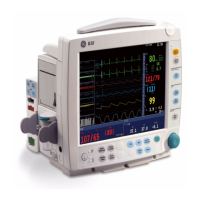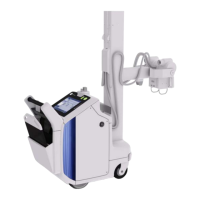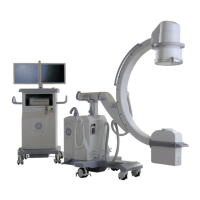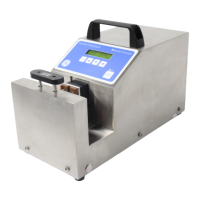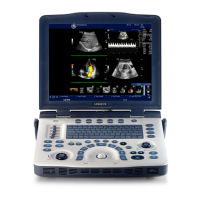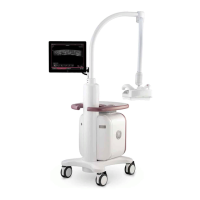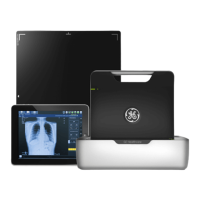
Do you have a question about the GE Healthcare Brivo XR118 and is the answer not in the manual?
| Brand | GE |
|---|---|
| Model | Healthcare Brivo XR118 |
| Category | Medical Equipment |
| Language | English |
Explains hazard symbols, signal words, and safety information structure.
Defines signal words like DANGER, WARNING, Caution and their meanings.
Illustrates graphical icons used to represent specific hazards and their meanings.
Describes text styles and prefixes used for general information and emphasis.
Explains headers, footers, and symbol usage for page navigation and information.
Defines character styles for computer output and input, including fixed and variable text.
Differentiates and explains representation of hard keys (buttons/switches) and soft keys (software buttons).
Procedure for safely de-energizing equipment using Lock-Out/Tag-Out (LOTO).
Details the system power LOTO procedure, including energy sources and locks.
Steps for preparing the system and safely energizing power after service.
Pre-energization checks and voltage matching to prevent equipment damage.
Procedure for safely shutting down and de-energizing the system.
Guidelines and precautions to prevent damage from static discharge.
Recommended grounding methods and equipment for ESD protection.
Overview of the manual's purpose and guidance for X-ray room installation.
Explains the manual's sequence and provides guidance on checking equipment.
Verifies completion of essential pre-installation tasks and planning.
Outlines the main steps for system installation, recognizing mechanical and electrical interfaces.
Detailed sequential tasks for installing the system, including checks and configurations.
Verifies that the target system meets technical requirements for compatibility and performance.
Pre-installation site checks for junction boxes, wiring, and power availability.
Guidance on routing and connecting system and power cables, emphasizing separation.
Procedures for routing MIS and power cables, ensuring rat-proofing and separation.
Steps for unpacking and connecting the wireless Access Point and PoE Ethernet Cable.
Procedures for connecting the wireless AP and PoE cable for system functionality.
Steps for unpacking and installing the digital detector, including battery replacement.
Guidance on placing the detector in table or wall stand housing and operating it.
Procedures for installing, upgrading, and backing up system software and data.
Covers what data to back up and the process for creating system backups.
Detailed procedure for installing or upgrading operating and application software.
Guides through configuring system parameters for installation, networking, and user accounts.
Instructions for configuring wired network IP settings for hospital network connectivity.
Management of user accounts, types, default accounts, and creation of new ones.
Instructions for configuring DICOM settings for network hosts and printers.
Configuration details for network hosts, including Host Tab and Preference Tab.
Details the required order for performing first installation calibrations.
Steps for calibrating the detector, including gain and bad pixel procedures.
Step-by-step instructions for performing gain calibration, including exposure techniques.
Steps for performing bad pixel calibration and verifying image quality.
Instructions for performing image quality tests using SUIF to check system performance.
Steps to check for artifacts that may impact clinical diagnostics using various exposure times.
Guidance on using built-in diagnostics tools for troubleshooting hardware issues.
Steps to access and utilize diagnostic tools for wireless detector, link, and communication issues.
Common software issues, boot failures, appsetup failures, and degraded mode troubleshooting.
Covers finding boot failures, appsetup failures, and system degraded mode issues with log analysis.
Troubleshooting DICOM related issues, including viewing headers and association time outs.
Instructions on using the DICOM Export tool to view header information without PACS transfer.
A detailed list of preventive maintenance operations, frequency, duration, and descriptions.
Lists recommended renewal parts and their required configuration or calibration after replacement.
Step-by-step guide for replacing the portable workstation battery.
Detailed instructions for replacing the workstation's SSD drive.
Steps for replacing the Wireless Access Point, covering both wall and shelf/table mounting.
Provides a functional block diagram showing MIS cables and their termination points.
Explains how to customize system preferences for various features like Worklist and Image Management.
Guides on setting Worklist preferences, including default query and preset names.
Controls HIS/RIS information on Worklist and configures auto-refresh.
Preferences for Copy Exam, Auto Tag, Auto Print, Auto Push, and Auto Delete functions.
Configures printer parameters for automatic printing based on Auto Tag.
Automatically transfers images to network devices after an exam is closed.
Settings for default factory looks, custom looks, and image processing parameters.
Allows modification of default processing settings for anatomical views.
Preferences for managing protocol database, including backup, retrieve, and edit functions.
Instructions for saving the entire protocol database to CD/DVD for safety.
